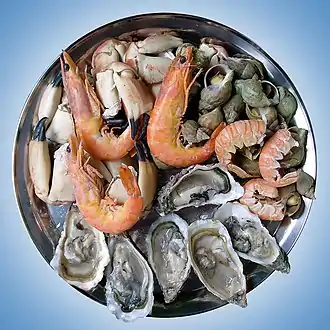Edible seaweed
Edible seaweed, or sea vegetables, are seaweeds that can be eaten and used for culinary purposes.[1] They typically contain high amounts of fiber.[2][3] They may belong to one of several groups of multicellular algae: the red algae, green algae, and brown algae.[2] Seaweeds are also harvested or cultivated for the extraction of polysaccharides[4] such as alginate, agar and carrageenan, gelatinous substances collectively known as hydrocolloids or phycocolloids. Hydrocolloids have attained commercial significance, especially in food production as food additives.[5] The food industry exploits the gelling, water-retention, emulsifying and other physical properties of these hydrocolloids.[6]
.jpg.webp)
Most edible seaweeds are marine algae whereas most freshwater algae are toxic. Some marine algae contain acids that irritate the digestion canal, while others can have a laxative and electrolyte-balancing effect.[7] Most marine macroalgae are nontoxic in normal quantities, but members of the genus Lyngbya are potentially lethal.[8] Typically, poisoning is caused by eating fish which have fed on Lyngbya or on other fish which have done so [8]; this is called ciguatera poisoning.[8] Handling Lyngbya majuscula can also cause seaweed dermatitis.[9] Some species of Desmarestia are highly acidic, with vacuoles of sulfuric acid that can cause severe gastrointestinal problems.[8]
The dish often served in western Chinese restaurants as 'Crispy Seaweed' is not seaweed but cabbage that has been dried and then fried.[10]
Distribution
Seaweeds are used extensively as food in coastal cuisines around the world. Seaweed has been a part of diets in China, Japan and Korea since prehistoric times.[11] Seaweed is also consumed in many traditional European societies, in Iceland and western Norway, the Atlantic coast of France, northern and western Ireland, Wales and some coastal parts of South West England,[12] as well as New Brunswick, Nova Scotia, and Newfoundland and Labrador. The Māori people of New Zealand traditionally used a few species of red and green seaweed,[13] and Indigenous Australians ate several species.[14]
Nutrition and uses

Seaweeds are a good source of nutrients such as proteins, vitamins, minerals, and dietary fiber. Polyphenols, polysaccharides, and sterols, as well as other bioactive molecules, are mainly responsible for the healthy properties associated with seaweed. If seaweeds are compared to terrestrial plants, they have a higher proportion of essential fatty acids as eicosapentaenoic (EPA) and docosahexaenoic (DHA) fatty acids.[15]
Seaweed contains high levels of iodine, tyrosine relative to other foods.[16] It is also rich in calcium and magnesium.[17]
Seaweed is a possible vegan source of Vitamin B12.[18] The vitamin is obtained from symbiotic bacteria.[19] However, mainstream nutrition consider algal B12 sources like seaweed unreliable.[20]
Seaweed are used in multiple cuisines:
- seaweed (Nori) wrapped sushi, maki
- seaweed in soup, stew, hot pot
- seaweed in salad
- seaweed snacks (eg. Tong Garden, Dae Chun Gim)
- seaweed in instant noodles (eg. Jongga, Four Seas, Nongshim)
- seaweed as food for livestock[21]
Seaweeds are rich in polysaccharides that could potentially be exploited as prebiotic functional ingredients for both human and animal health applications. Prebiotics are non-digestible, selectively fermented compounds that stimulate the growth and/or activity of beneficial gut microbiota which, in turn, confer health benefits on the host.[22] In addition, there are several secondary metabolites that are synthesized by algae such as terpenoids, oxylipins, phlorotannins, volatile hydrocarbons, and products of mixed biogenetic origin. Therefore, algae can be considered as a natural source of great interest, since they contain compounds with numerous biological activities and can be used as a functional ingredient in many technological applications to obtain functional foods. Polysaccharides in seaweed may be metabolized in humans through the action of bacterial gut enzymes. Such enzymes are frequently produced in Japanese population due to their consumption of seaweeds.[23]
Chondrus crispus (commonly known as Irish moss) is another red alga used in producing various food additives, along with Kappaphycus and various gigartinoid seaweeds.
As a nutraceutical product, some edible seaweeds are associated with anti-inflammatory, anti-allergic, antimutagenic, antitumor, antidiabetic, antioxidant, antihyperthensive and neuroprotective properties. Edible red macroalgae such as Palmaria palmata, (Dulse), Porphyra tenera (Nori) and Eisenia bicyclis have been measured as a relevant source of "alternative protein, minerals, and, eventually, fiber."[24]
Feeding the seaweed Asparagopsis taxiformis to cows can reduce their methane emissions.[25]
East Asia
In some parts of Asia, nori 海苔 (in Japan), zicai 紫菜 (in China), and gim 김 (in Korea), sheets of the dried red alga Porphyra are used in soups or to wrap sushi or onigiri.
Japanese cuisine has common names for seven types of seaweed, and thus the term for seaweed in Japanese is used primarily in scientific applications, and not in reference to food.
Agar-agar (kanten 寒天), probably first discovered in Japan, is also widely used as a substitute for gelatin.[26]
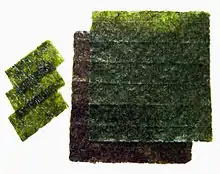
 Dasima (kelp)
Dasima (kelp)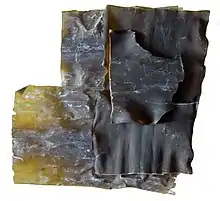
 Cakes and Food Made of Seaweed by Kubo Shunman, 19th century
Cakes and Food Made of Seaweed by Kubo Shunman, 19th century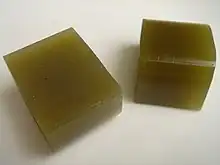
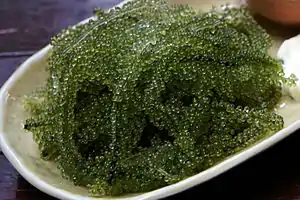 Sea grapes, a tropical edible seaweed, are also eaten in Japan, either imported from the Philippines (where it originates) or grown in Okinawa
Sea grapes, a tropical edible seaweed, are also eaten in Japan, either imported from the Philippines (where it originates) or grown in Okinawa
Southeast Asia
Sea grapes (Caulerpa lentillifera and Caulerpa racemosa) and Gusô (Eucheuma spp.) are traditionally eaten in the cuisines of Southeast Asia (as well as in Oceania and warmer areas of East Asia).[27] These edible warm-water seaweed were first commercially cultivated in the Philippines. In the northern Philippines, the cold-water red seaweed Pyropia vietnamensis is also traditionally harvested from the wild and dried into black nori-like sheets called gamet which are used as ingredients in cooking.[28][29][30]
In the Philippines, a traditional ingredient is gulaman, which is made from carrageenan extracted from edible seaweed in the pioneering tropical seaweed farming industry in the country. It is also used as a substitute for gelatin. It is widely used in various traditional desserts.[31] Carrageenan as a gelatin substitute has also spread to other parts of Southeast Asia, like in Indonesia, where it is used for desserts like es campur.
Seaweed is also processed into noodles by residents of Tiwi, Albay, which can be cooked into pancit canton, pancit luglug, spaghetti or carbonara.[32] Cooking with seaweed flakes has become more and more popular in the western hemisphere.[33]
_(26420465388).jpg.webp) Sea grapes (Caulerpa lentillifera) were originally cultivated in the Philippines. They are usually eaten raw with vinegar, as a snack or in a salad.[34]
Sea grapes (Caulerpa lentillifera) were originally cultivated in the Philippines. They are usually eaten raw with vinegar, as a snack or in a salad.[34]_in_a_wet_market_in_the_Philippines.jpg.webp) Gusô (Eucheuma spp.), another edible tropical seaweed species originally cultivated in the Philippines. They are eaten fresh, similar to sea grapes, or processed into carrageenan.
Gusô (Eucheuma spp.), another edible tropical seaweed species originally cultivated in the Philippines. They are eaten fresh, similar to sea grapes, or processed into carrageenan.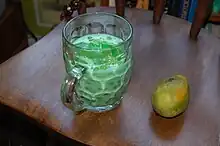 Buko pandan, a dessert beverage from the Philippines made with pandan-flavored cubes of gulaman, a gelatin-substitute made from carrageenan
Buko pandan, a dessert beverage from the Philippines made with pandan-flavored cubes of gulaman, a gelatin-substitute made from carrageenan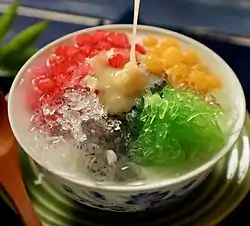
Common edible seaweeds
Common edible seaweeds[35] include:
Red algae (Rhodophyta)
Green algae
|
Brown algae (Phaeophyceae)Kelp (Laminariales)
Fucales
Ectocarpales
|
See also
- Aquaculture of giant kelp – Cultivation of seaweed
- Seaweed farming – Farming of aquatic seaweed
- Seaweed oil
References
- Reynolds, Daman; Caminiti, Jeff; Edmundson, Scott J.; Gao, Song; Wick, Macdonald; Huesemann, Michael (2022-10-06). "Seaweed proteins are nutritionally valuable components in the human diet". The American Journal of Clinical Nutrition. 116 (4): 855–861. doi:10.1093/ajcn/nqac190. ISSN 0002-9165. PMID 35820048.
- Garcia-Vaquero, M; Hayes, M (2016). "Red and green macroalgae for fish and animal feed and human functional food development". Food Reviews International. 32: 15–45. doi:10.1080/87559129.2015.1041184. hdl:10197/12493. S2CID 82049384.
- K.H. Wong, Peter C.K. Cheung (2000). "Nutritional evaluation of some subtropical red and green seaweeds: Part I — proximate composition, amino acid profiles and some physico-chemical properties". Food Chemistry. 71 (4): 475–482. doi:10.1016/S0308-8146(00)00175-8.
- Garcia-Vaquero, M; Rajauria, G; O'Doherty, J.V; Sweeney, T (2017-09-01). "Polysaccharides from macroalgae: Recent advances, innovative technologies and challenges in extraction and purification". Food Research International. 99 (Pt 3): 1011–1020. doi:10.1016/j.foodres.2016.11.016. hdl:10197/8191. ISSN 0963-9969. PMID 28865611. S2CID 10531419.
- Round F.E. 1962 The Biology of the Algae. Edward Arnold Ltd.
- Garcia-Vaquero, M; Lopez-Alonso, M; Hayes, M (2017-09-01). "Assessment of the functional properties of protein extracted from the brown seaweed Himanthalia elongata (Linnaeus) S. F. Gray". Food Research International. 99 (Pt 3): 971–978. doi:10.1016/j.foodres.2016.06.023. hdl:10197/8228. ISSN 0963-9969. PMID 28865623.
- Wiseman, John SAS Survival Handbook
- Turner, Nancy J.; von Aderkas, Patrick (2009). "3: Poisonous Plants of Wild Areas". The North American Guide to Common Poisonous Plants and Mushrooms. Portland, OR: Timber Press. pp. 115–6. ISBN 9780881929294. OCLC 747112294.
- James, William D.; Berger, Timothy G.; et al. (2006). Andrews' Diseases of the Skin: clinical Dermatology. Saunders Elsevier. ISBN 978-0-7216-2921-6.
- Hom, Ken (2012). "Crisp Seeweed". Good Food Channel. UK TV.CO.UK. Retrieved 16 October 2014.
- "Seaweed as Human Food". Michael Guiry's Seaweed Site. Retrieved 2011-11-11.
- "Spotlight presenters in a lather over laver". BBC. 2005-05-25. Retrieved 2011-11-11.
- "Kai Recipe's used by Kawhia Maori & Early Pioneers". Kawhia.maori.nz. Retrieved 2011-11-11.
- Thurstan, R. H.; Brittain, Z.; Jones, D. S.; Cameron, E.; Dearnaley, J.; Bellgrove, A. (2018-01-23). "Aboriginal uses of seaweeds in temperate Australia: an archival assessment". Journal of Applied Phycology. 30 (3): 1821–1832. doi:10.1007/s10811-017-1384-z. hdl:10871/31766. ISSN 0921-8971. S2CID 22620932.
- Peñalver, Rocío; Lorenzo, José M.; Ros, Gaspar; Amarowicz, Ryszard; Pateiro, Mirian; Nieto, Gema (2020). "Seaweeds as a Functional Ingredient for a Healthy Diet". Marine Drugs. 18 (6): 301. doi:10.3390/md18060301. PMC 7345263. PMID 32517092.
- "Micronutrient Information Center: Iodine". Oregon State University: Linus Pauling Institute. 2014-04-23. Retrieved 2011-11-11.
- "Albay folk promote seaweed 'pansit'". ABS-CBN Regional Network Group. 2008-04-08. Retrieved 2009-08-04.
- Watanabe, Fumio; Yabuta, Yukinori; Bito, Tomohiro; Teng, Fei (2014-05-05). "Vitamin B12-Containing Plant Food Sources for Vegetarians". Nutrients. 6 (5): 1861–1873. doi:10.3390/nu6051861. ISSN 2072-6643. PMC 4042564. PMID 24803097.
- Smith AG (2019-09-21). "Plants need their vitamins too". Current Opinion in Plant Biology. 10 (3): 266–75. doi:10.1016/j.pbi.2007.04.009. PMID 17434786.
- Melina V, Craig W, Levin S (2016). "Position of the Academy of Nutrition and Dietetics: Vegetarian Diets". J Acad Nutr Diet. 116 (12): 1970–80. doi:10.1016/j.jand.2016.09.025. PMID 27886704. S2CID 4984228.
Fermented foods (such as tempeh), nori, spirulina, chlorella algae, and unfortified nutritional yeast cannot be relied upon as adequate or practical sources of B-12.39,40 Vegans must regularly consume reliable sources—meaning B-12 fortified foods or B-12 containing supplements—or they could become deficient, as shown in case studies of vegan infants, children, and adults.
- Makkar, Harinder P.S.; Tran, Gilles; Heuzé, Valérie; Giger-Reverdin, Sylvie; Lessire, Michel; Lebas, François; Ankers, Philippe (2016). "Seaweeds for livestock diets: A review". Animal Feed Science and Technology. 212: 1–17. doi:10.1016/j.anifeedsci.2015.09.018.
- O'Sullivan, L.; Murphy, B.; McLoughlin, P.; Duggan, P.; Lawlor, P. G.; Hughes, H.; Gardiner, G. E. (2010). "Prebiotics from Marine Macroalgae for Human and Animal Health Applications". Marine Drugs. 8 (7): 2038–2064. doi:10.3390/md8072038. PMC 2920542. PMID 20714423.
- Hehemann, Jan-Hendrik; Correc, Gaëlle; Barbeyron, Tristan; Helbert, William; Czjzek, Mirjam; Michel, Gurvan (8 April 2010). "Transfer of carbohydrate-active enzymes from marine bacteria to Japanese gut microbiota". Nature. 464 (7290): 908–912. Bibcode:2010Natur.464..908H. doi:10.1038/nature08937. PMID 20376150. S2CID 2820027.
- Catarina, Costa; Filipa, Pimentel; Rita, Alves; Anabela, Costa; Arminda, Alves; Beatriz, Oliveira (2014). "Nutritional profile of edible red marine seaweeds". Frontiers in Marine Science. 1. doi:10.3389/conf.fmars.2014.02.00091. ISSN 2296-7745. OCLC 5707377199. Archived from the original on September 3, 2020.
- Milman, Oliver (2021-03-18). "Feeding cows seaweed could cut their methane emissions by 82%, scientists say". The Guardian. Archived from the original on 2021-03-18. Retrieved 2021-11-24.
- Nunez, Kirsten (31 December 2019). "4 Gelatin Substitutes Every Vegan or Vegetarian Needs to Try". Clean Green Simple. Retrieved 11 November 2021.
- Paul, Nicholas A.; Neveux, Nicolas; Magnusson, Marie; de Nys, Rocky (21 December 2013). "Comparative production and nutritional value of "sea grapes" — the tropical green seaweeds Caulerpa lentillifera and C. racemosa". Journal of Applied Phycology. doi:10.1007/s10811-013-0227-9. S2CID 15745994.
- Adriano, Leilanie G. (21 December 2005). "'Gamet' sushi festival launched". The Manila Times. Retrieved 15 August 2021.
- "Gamet". Museo Ilocos Norte. 28 May 2016. Retrieved 15 August 2021.
- "Cagayan town passes seaweed protection law". The Manila Times. 15 December 2013. Retrieved 15 August 2021.
- Montaño, Marco Nemesio E. (16 September 2004). "Gelatin, gulaman, 'JellyAce,' atbp". PhilStar Global. Retrieved 11 November 2021.
- Blogger, Meridian Sea. "Cooking with Seaweed and the Health Benefits - Seaweed Varieties in UK". Meridian Sea Limited.
- "Famadillo - How to use seaweed flakes". Archived from the original on 12 April 2023.
- Dawes, Clinton J. (1998). Marine botany. New York: John Wiley. ISBN 978-0-471-19208-4.
- Harrison, M. (2008). "Edible Seaweeds around the British Isles". Wild Food School. Archived from the original on 2015-07-21. Retrieved 2011-11-11.
External links
- Seaweeds used as human food an FAO report
